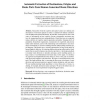Free Online Productivity Tools
i2Speak
i2Symbol
i2OCR
iTex2Img
iWeb2Print
iWeb2Shot
i2Type
iPdf2Split
iPdf2Merge
i2Bopomofo
i2Arabic
i2Style
i2Image
i2PDF
iLatex2Rtf
Sci2ools
GISCIENCE
2010
Springer
2010
Springer
Automatic Extraction of Destinations, Origins and Route Parts from Human Generated Route Directions
Researchers from the cognitive and spatial sciences are studying text descriptions of movement patterns in order to examine how humans communicate and understand spatial information. In particular, route directions offer a rich source of information on how cognitive systems conceptualize movement patterns by segmenting them into meaningful parts. Route directions are composed using a plethora of cognitive spatial organization principles: changing levels of granularity, hierarchical organization, incorporation of cognitively and perceptually salient elements, and so forth. Identifying such information in text documents automatically is crucial for enabling machine-understanding of human spatial language. The benefits are: a) creating opportunities for large-scale studies of human linguistic behavior; b) extracting and georeferencing salient entities (landmarks) that are used by human route direction providers; c) developing methods to translate route directions to sketches and maps; and...
| Added | 09 Nov 2010 |
| Updated | 09 Nov 2010 |
| Type | Conference |
| Year | 2010 |
| Where | GISCIENCE |
| Authors | Xiao Zhang, Prasenjit Mitra, Alexander Klippel, Alan M. MacEachren |
Comments (0)

